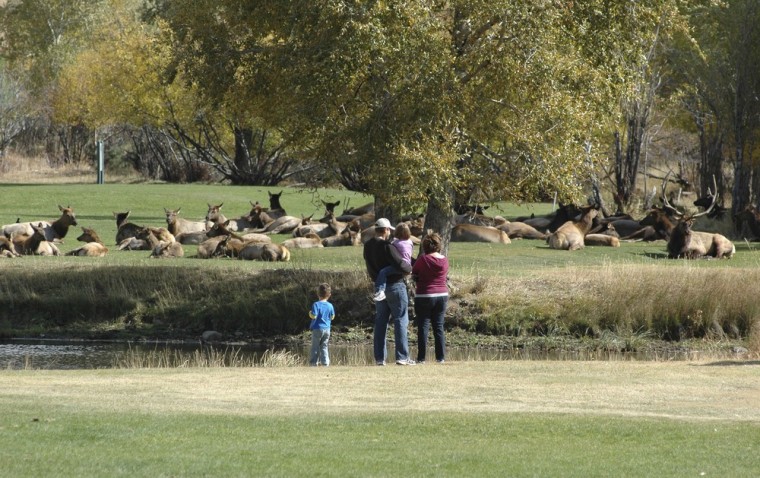There are certain signs of fall in the town of Estes Park: the chill of morning frost, the reds and yellows of autumn leaves, and the thousands of elk that visit.
The elk come looking for romance; the tourists come looking for elk. And find them they do: in parks, around residential neighborhoods and in the middle of the street blocking traffic.
So prevalent are the elk that one visitor from Texas called the Convention & Visitors Bureau asking where to find the "wild elk," not the tame ones lounging around town, said Suzy Blackhurst, who fielded the call.
During the summer, the elk generally live at higher elevations in adjacent Rocky Mountain National Park. In September and October, they descend to Estes Park (elevation 7,500 feet) to rut or mate.
With the rut comes the elk bugle — a long, haunting call. As individual as the human voice, some bulls emit a deep resonant sound that has been compared to Tibetan throat singing. Others let loose with a higher-pitched blood-curdling scream.
Attract and repel
The bugle serves a dual purpose. It is used by mature bulls to attract cows, and is also used by "stud" elk to intimidate rival males who may want to move in on their harem.
If the bugle and an impressive rack aren't enough to ward off opponents, they fight, locking antlers in what generally amounts to a shoving match. Although the bulls stand about 5 feet tall at the shoulder and weigh up to 1,100 pounds, they must avoid injury and conserve their energy to survive the winter. As a result, most fights are brief.
But Blackhurst was on the nine-hole golf course last year when she witnessed a savage battle that lasted at least five minutes.
Although her group had tried to steer clear of the elk, the dueling bulls moved closer and closer, forcing the golfers to take refuge behind a tree.
"They were going at each other head-to-head and really trying to win," she said. "The larger, older bull lost. He limped away with a big gash in his neck. It was very gory."
The action usually takes place at dawn, and again from late afternoon until dusk. During the day, the herds rest, with a single bull sometimes overseeing three dozen cows and calves.
All about elk
Elk are revered here all year long. The police have an elk on their shoulder patch, the Estes Park Brewery makes a Staggering Elk Lager, and the Wapiti Restaurant and Pub — named for the Shawnee word for elk — offers a money-back satisfaction guarantee on its namesake cuisine.
But during the rut, the town welcomes the elk with even greater enthusiasm.
An annual Elk Fest is held each fall, with this year's event set for Oct. 1-2. It features bugling competitions, educational areas, Native American storytelling and music, and guided elk-viewing tours. Vendors sell items made from various parts of the animal, including jewelry made from the ivory elk teeth, scrimshawed antler knives, antler lamps, elk hide pillows, elk jerky and more.
Indeed, a quarter of the 325,000 people who stopped at the Estes Park Visitors Center last year came during September and October. There is no way of knowing how many bypassed the center altogether, but roughly 3 million people visited Rocky Mountain National Park to enjoy the clear crisp days and changing aspen leaves, so it could number in the hundreds of thousands.
With all those visitors and all those elk, it can sometimes be a challenge to keep curious sightseers and high-strung bulls away from one another. Elk have been known to ram cars and golf carts.
"We just try to keep everybody safe," said Mark Miller, general manager of the Estes Park Golf Course, who estimated 100 to 150 elk are on the 18-hole course each day during the rut. "It's a daily routine for our maintenance department. They have to clean up after them and repair their damage."
Volunteers, called the Bugle Corps, help by educating tourists and answering questions, and police step in to move bystanders when an elk seems especially aggressive. But it's all part of autumn in Estes Park.
"We love the elk and we love the interaction we have with them here," said town spokeswoman Kate Rusch. "It's pretty unique."
